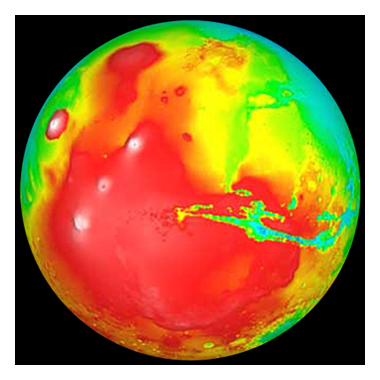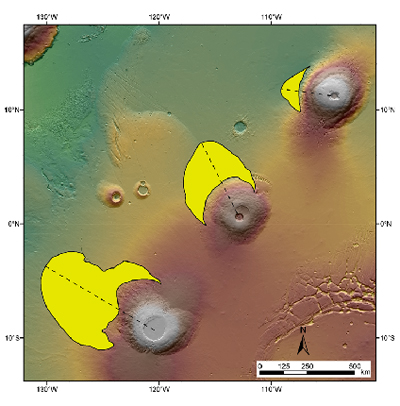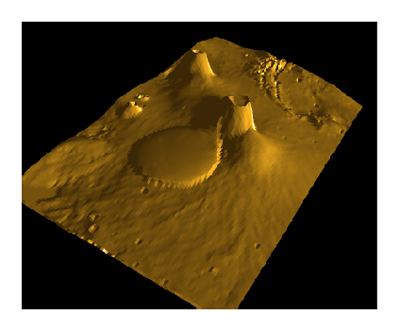Terrestrial Background and Application to Arsia Mons Lobate Deposit, Mars

Extraterrestrial Glaciology began when researchers recognized that certain landforms had been produced by large sheets of moving ice that covered wide expanses of the landscape. Obviously, these moving ice mountains could only have existed if the world had been colder. Had they come and gone repeatedly in the past, and if so, how many times? Is it possible that the ice age state of the world is its normal state? Would the glaciers come again, and when? All of these questions are as relevant to the planet Mars as they are to the planet Earth.
On Earth, it was clear that the waxing and waning of the ice sheets had occurred in relatively recent geological time and were related. With glacial periods typically lasting 105 years, and interglacial periods 104 years, the ice age state is more the norm than the exception. Now, evidence from Mars suggests that ice ages have come and gone and that proper understanding of these glacial imprints can expand our understanding of how much, and more importantly where, water exists on Mars.
Dynamic models allow us to reconstruct the shape of ice sheets of the past. The ice sheet margin is identified by glacial geological indicators, and then the interior thickness can be calculated from various conservation laws and constitutive relationships. In developing these models, assumptions are made about material constants that describe how ice responds to various forces. Commonly these parameters must be obtained experimentally by fitting the output of the model to the known configuration of an existing ice sheet. On Earth, this can be done by modeling existing ice sheets such as exist in the Antarctic and Greenland. On Mars, we can use our experience with terrestrial ice sheets. For instance, the hardness of ice, an important parameter in the flow low of ice, has been determined to vary as an exponential function of the temperature. While ice on Mars may contain more dust than terrestrial ice, it is still fundamentally the same material, and should follow the same physical laws.


Image Credit: Mars Orbiter Laser Altimeter (MOLA), an instrument aboard NASA's Mars Global Surveyor, produced by Goddard Space Flight Center.
Model Input
The primary inputs to an ice sheet model are the bed topography, the accumulation rate, the surface temperature, and the geothermal heat flux.
Bed Topography
The bed topography is well-known on Mars, primarily from the Mars Orbiter Laser Altimeter (MOLA). This, combined with images from the Mars Orbiter Camera (MOC), provide most of the evidence for the existence of ice sheets on Mars. Ice sheet modeling requires a representation of the bed topography with a spatial resolution comparable to the ice thickness.
Surface Temperature
While there are measurements of the current surface temperature on Mars (216-218° K) near the equator for ice sheet reconstructions, it is necessary to have some estimates of how the climate may have changed in the past. One estimate of temperature based on a climate model for periods of high obliquity is 207-213° K.
Geothermal Heat
This is very poorly constrained for Mars. The expected values for Tharsis could be much higher or lower than the planetary mean, depending on time of formation and crustal thickness estimates.
Accumulation Rate
On Earth, glaciers usually have an equilibrium line altitude (ELA) above which the accumulation rate is positive (increasing ice thickness) and below which it is negative (decreasing ice thickness). The forward flow of ice balances these two components, determining the length and overall mass balance of the glacier. If the positive component dominates, the glacier will advance and grow larger. If the negative component dominates the glacier will shrink.
Selected References
Fastook, J.L., J.W. Head, D.R. Marchant and D.E. Shean, 2004. Ice Sheet Modeling: Terrestrial Background and Application to Arsia Mons Lobate Deposit, Mars. 35th Lunar and Planetary Science Conference, March 15-19, 2004, Houston TX.
Shean, D.E., J.W. Head, J.L. Fastook and D.R. Marchant, 2004. Tharsis Montes Cold-based Glaciers: Observations and Constraints for Modeling and Preliminary Results. 35th Lunar and Planetary Science Conference, March 15-19, 2004, Houston TX.

